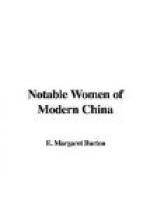Gradually health and strength came back, and the next year it was reported that Dr. Hue had sufficiently recovered her health to teach one class in the Girls’ Boarding School. A trip to the home of a married sister in Amoy, which gave her a sea voyage, and change of air and scene, completed her recovery and in 1899 she was strong enough to take charge of the Woolston Memorial Hospital.
[Illustration: Dr. Hue’s Medical Students]
The Foochow Hospital for women and children is situated on Nan Tai Island, three miles from the walled city of Foochow. The physicians had long felt the need of a similar work within the city walls, and a few years before Dr. Hue’s return from America, work had been undertaken in the city. A small building was erected, in which forty in-patients could be accommodated. This little building was named the Woolston Memorial Hospital, and nurses from the Island hospital took turns in working in it, under the supervision of one of the physicians. But until Dr. Hue took charge of the work, in 1899, there had been no resident physician.
Some years later, in telling of her appointment to this work, Dr. Hue said: “It is very different from what I had heard of the city people being proud and hard to manage. I am glad God created Lot. If he did not help any one else he surely helped me. At the time I said nothing and went, simply because I did not want to be like Lot. No one knows how I shrank when I was asked to work in the city; for when I thought of the place, the pitiful picture of the Island hospital students would come most conspicuously before me. I can see them even now, wiping away the tears just as hard as they could when their turn came to go into the city; while the other students were like ‘laughing Buddhas,’ for their turn in the city hospital had expired. I am glad I can speak for myself to-day that in my five years’ experience I have never had to shed a tear because the people were obstinate.”
Nevertheless the first few months were not altogether easy ones. Dr. Hue herself tells the story of the beginnings of the work: “When I first took up my work in the city here, during the first few months what did I meet? People came and said that they wanted a foreign doctor. When our Bible woman told them that I had just returned from a foreign country, and that I knew foreign medicine, what was the immediate reply which I heard? ’No, I don’t want a Chinese student, but I want a foreign doctor.’ It made my Bible woman indignant, but by this time I usually stepped out and told them just where to go to find the foreign doctors. It surprised my hospital people that instead of feeling hurt I would do what I did.”
It was only a few months, however, before the city people discovered that this “Chinese student” was a most valuable member of the community. By summer the work of the little hospital was so prosperous that Dr. Hue decided to keep the dispensary open for three mornings a week, even after the intense heat had necessitated the closing of the hospital proper. Some of the patients signified their approval of this decision by renting rooms in the neighbourhood, in order to be able to attend the dispensary on the open days.




